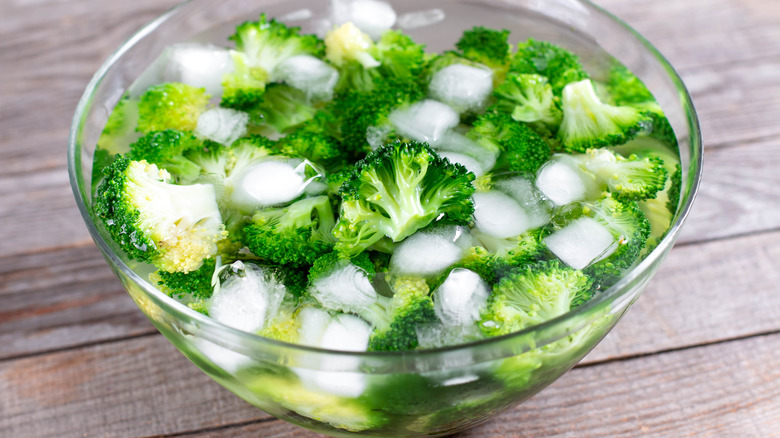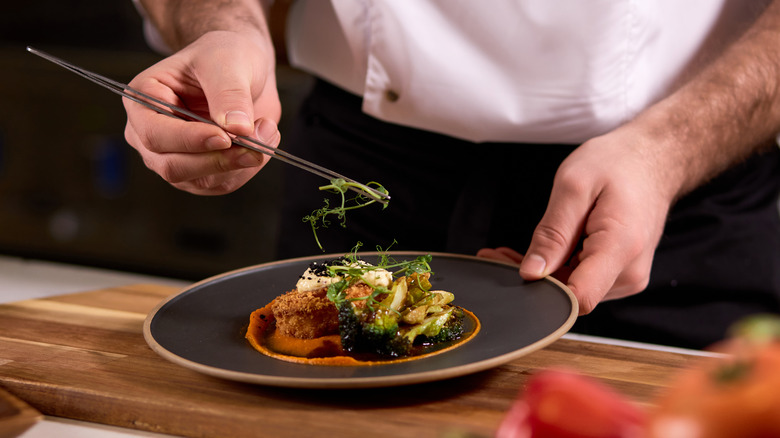Why Vegetables Taste Better At Restaurants Than At Home
Many home chiefs lament the extreme difference between their attempts to cook palatable vegetables and the flavorful and crisp vegetable dishes that restaurants produce. Frequently, the default answer to this problem is that restaurants add absurd amounts of fats, sugars, and salts to their vegetable dishes, explains OOLA. Others chalk up the difference to animal fats like bacon grease. These solutions leave vegetarians and health-conscious home cooks feeling defeated and resigned to lives of slimy tasteless veggies (via Eating Made Easy).
The truth is that more salt and fat do factor into better-tasting veggies. That said, making an enjoyable and relatively healthy vegetable dish that is delicious and satisfying is very much possible. There are plenty of ways to improve your at-home veggie game. First, like many restaurants, pay attention to what's in season, says Country Living. In-season vegetables taste better and have more nutrients. As a bonus, in-season produce is typically more affordable too.
Next, consider how you're cooking your vegetables. If you're steaming or boiling your veggies, chances are you're used to sad and lifeless results. Consider changing up your method. Consider roasting, air frying, or grilling to get crispy and brown exteriors. Lexi Endicott, RD, LD, CCMS, told The Beet that "Roasting brings out the natural sweetness in vegetables and creates an enjoyable texture." If you want a better result that's not roasted, try sautéing.
Shake up your prep routine
To get restaurant-quality vegetables at home, change up how you prep and when you salt. Salt significantly improves your veggie's taste and is also a flavor enhancer. Avoid adding herbs and spices without salt since it's the salt that makes all the flavors pop. Ethan Chlebowski suggests adding salt to chopped vegetables a few hours before you begin cooking to help the salt set in. If you're sautéing leafy greens, try massaging them with salt to rid them of their bitter taste and to make them more digestible.
Before you sauté your vegetable dish, try blanching the vegetables in salted water. This step will improve the taste by adding salt and removing the vegetal bitterness, says Country Living. Additionally, blanching preserves the vegetable's crispy texture and color. To blanch your vegetables, boil your chopped for 2-3 mins before submerging them in an ice bath. Then, proceed with your recipe.
For root vegetables like potatoes and carrots, Chlebowski suggests parboiling them. Like blanching, boil sliced root veggies in salt water for 6-8 minutes, drain and then roast for another 10-15 minutes at 450-475 degrees. Whether you parboil or not, he urges home cooks to use hotter temperatures and roast their veggies for longer. Veggies need to get rid of their moisture to get that satisfyingly crispy texture. Otherwise, you get sogginess. Increasing the temperature and roast time helps. Chlebowski suggests aiming for 30-45 minutes at 450-475 degrees.
Get fearless with fat and garnishes
You don't have to slather your vegetables in several ounces of animal fat or oil to get a good-tasting final product. That said, fat does help spread both heat and flavor throughout your dish, explains Ethan Chlebowski. He suggests 1-2 tablespoons of oil per sheet pan for roasting vegetables. If you're using an oven, try oiling your pan and adding the pan to the oven as it preheats. Also, space out your vegetables on the pan. Packing them too tightly will also lead to mushy results.
Finally, consider how you finish your veggie dish. You can still add salt and pepper if there's not enough flavor. For those fearful of too much salt, use liquid aminos for a better taste, says The Beet. Add an acid like a squeeze of citrus for a satisfying additional layer of flavor. If there's not enough oil, a final drizzle of a flavored oil is an excellent finishing touch. Country Living recommends garnishing your veggie dish with fresh herbs. Try basil, thyme, rosemary, or parsley. There's also nothing wrong with a little grated parmesan or another kind of cheese. With these tips, near-restaurant-quality vegetable dishes are well within your reach.


